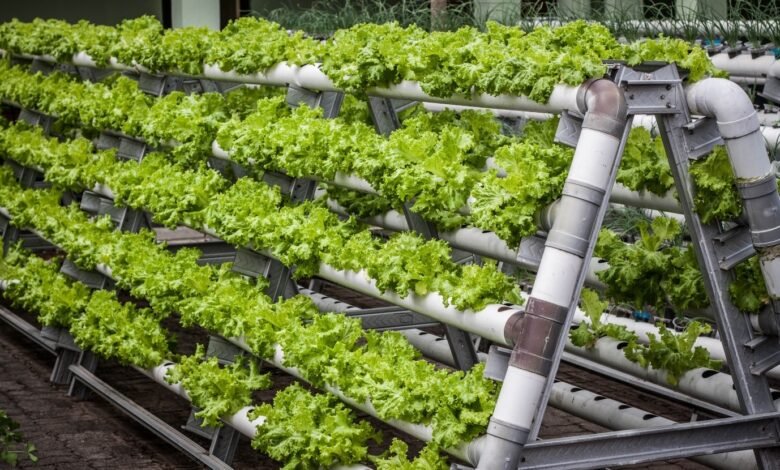Vertical Farming: Solutions for Agricultural Challenges
Vertical Farming: An Innovative Approach

Vertical farming is a modern agricultural method that involves using hydroponic or aeroponic culture systems to produce crops vertically stacked in a protected indoor space. There are many potential advantages to vertical farming, such as better space use, less water use, faster growing seasons, less need for pesticides and herbicides, and protection from bad weather.
The increasing population and present supply chain disruptions have led experts to conclude that vertical farming is a necessary and feasible solution. Due to the unfavorable consequences of climate change, scarce water supplies, and restricted land availability, conventional farming methods are under tremendous strain. The goals of vertical farming are to minimize environmental effect, maximize resource efficiency, and increase space utilisation.
We shall delve more into the idea of vertical farming in this blog.
Vertical Farming: An Innovative Approach
Cultivating crops in vertically piled layers or vertically tilted surfaces was the idea behind vertical farming, a new way to agriculture. Vertical farming uses multi-story buildings, skyscrapers, and specifically constructed structures that well-equipped with artificial lighting, climate control systems, and hydroponic or aeroponic cultivation technologies. This is in contrast to conventional farming, which depends on enormous swaths of land. A range of crops can be produced year-round in controlled surroundings through the use of vertical farming, which is independent of outside influences.
The Evolution of Vertical Farming
There are reports that the Hanging Gardens of Babylon was where the idea of vertical gardening originated. But as technology developed and the necessity for sustainable food production became more pressing, modern vertical farming underwent a substantial evolution. The 20th century saw the invention of hydroponics, which allowed plants to thrive in nutrient-rich water rather than soil, completely changing indoor farming. This led to the evolution of the idea of vertical farming into what it is today.
Modern vertical farming has come a long way because of developments in automation, data analytics, and lighting systems. Energy-efficient LED lighting has taken the role of conventional fluorescent lighting, providing fine control over light intensity and spectrum to maximize plant development. Robotic technologies like sowing, harvesting, and monitoring have reduced labor requirements and increased operational efficiency.
Importance of Vertical Farming in India
Effective Use of Resources: Compared to traditional farming, which needs enormous land expanses, vertical farming can provide much higher yields per unit area. A single vertical farm may really be able to generate as much food as several acres of conventional agriculture, according to some calculations. The capacity to stack plant layers, each of which offers ideal growing conditions in terms of temperature, humidity, and light, makes this feasible.
Reduced Environmental Impact: Vertical farms use less pesticides and fertilizers, which reduces chemical runoff and soil contamination. They also use LED lighting and optimal growing conditions. You can get a Mahindra 585 DI as it is also an environment friendly tractor.
Decreased Water Usage: Compared to traditional agriculture, vertical farming consumes a great deal less water—up to 70% less, according to some estimates. This made possible by hydroponic systems, which provide exact control over the plants’ watering schedule.
Reducing the Effects of Climate Change: Since vertical farming is done indoors and is not weather-dependent, it is mostly protected from harsh weather occurrences. This implies that despite shifting weather patterns, vertical farming may offer a consistent and dependable supply of food.
Adoption’s Obstacles
However, there are certain obstacles to the widespread adoption of vertical farming despite its potential advantages:
High Energy Costs: One of the biggest challenges is the high energy costs involved in indoor farming, especially when it comes to temperature control and lighting. Modern developments in renewable energy technologies, like solar panels, can lessen these expenses and increase vertical farming’s overall sustainability.
High Initial Investment: Arranging up a vertical farm needs a big initial investment, which can be a major barrier to entry for small-scale farmers. This is another challenge. But as the sector expands, economies of scale should reduce costs and increase accessibility to vertical farming.
One More Modification in Our Changing World
Throughout history, agricultural innovations have been made to meet the needs of both the environment and humankind. However, as the world’s population increases, it is becoming more difficult to feed everyone and is also running out of arable land and other vital resources like fuel and water.
More nations may transition to sustainable farming as a result of the Netherlands and Singapore gradually setting the standard in the vertical farming sector. Vertical farming can be harvested all year round and uses less energy, water, and fossil fuels than traditional methods. In order to keep up with global population growth, more nations may adopt vertical farming in the ensuing decades in order to benefit from its environmental and economic advantages.
These are all about vertical farming and its challenges. For more information about Mahindra JIVO 305 DI VINEYARD 4WD price, stay connected with us.



